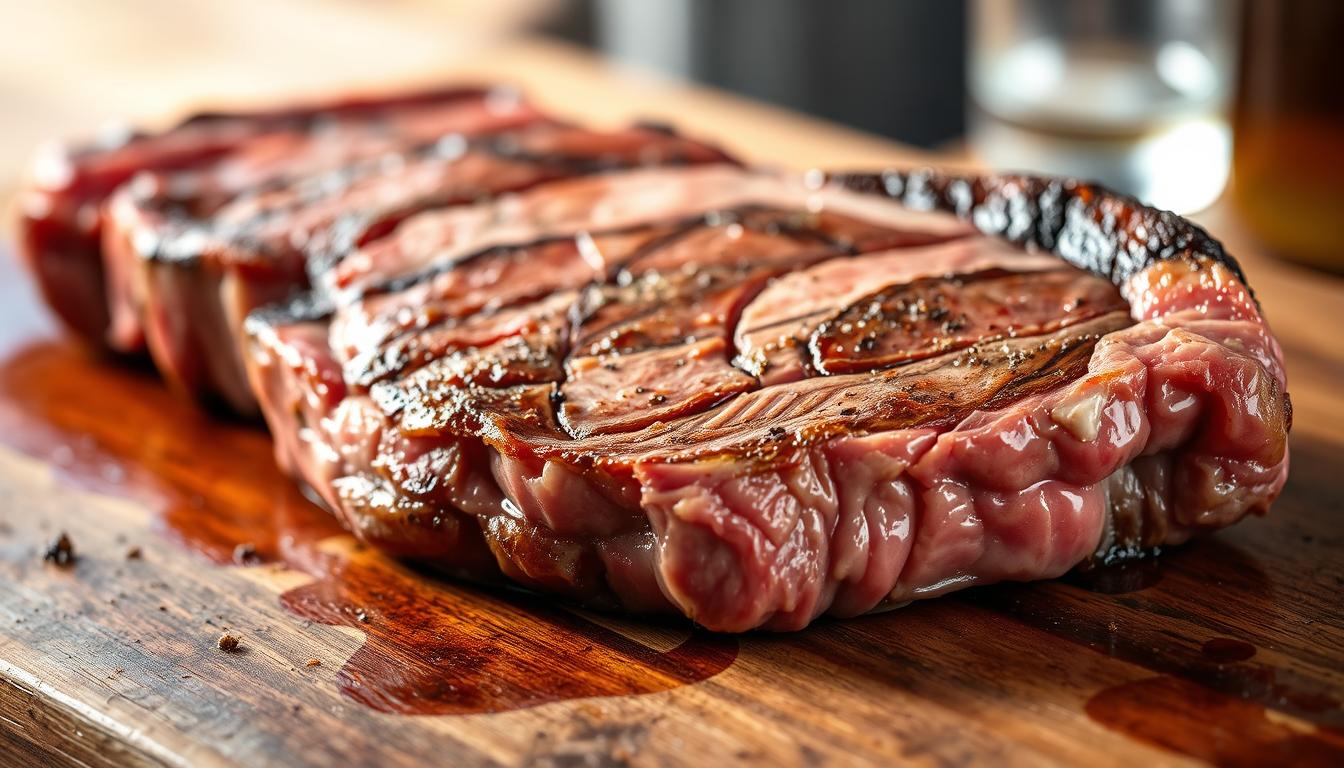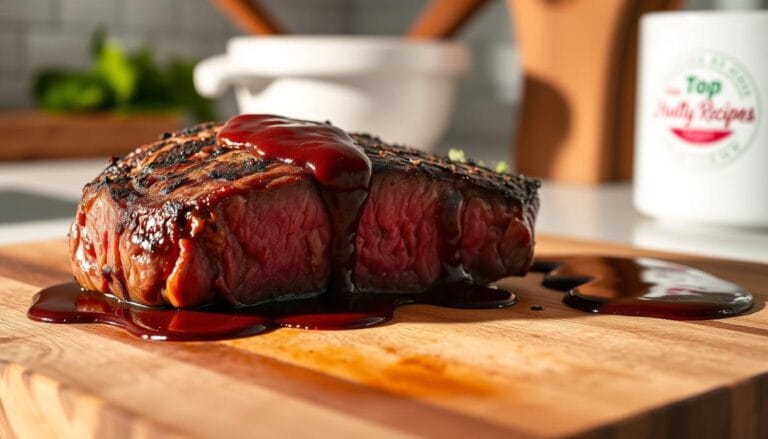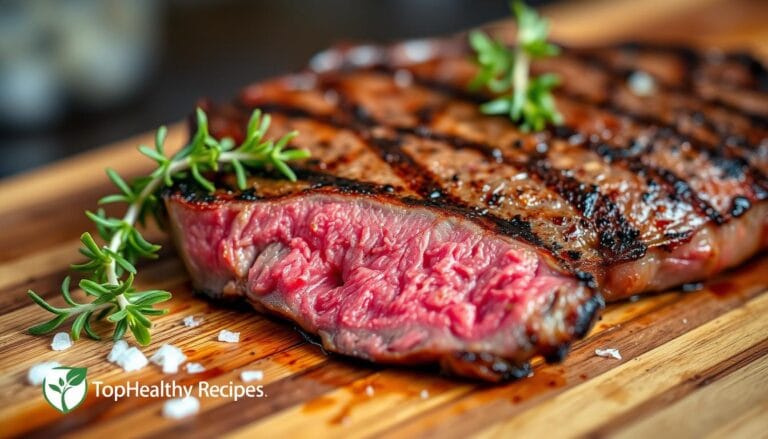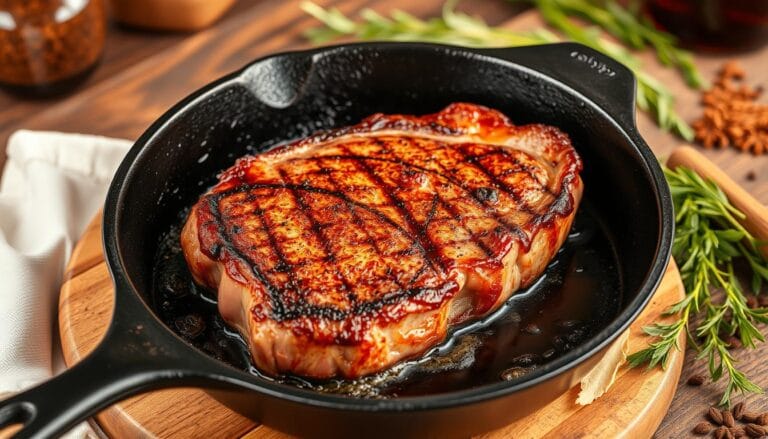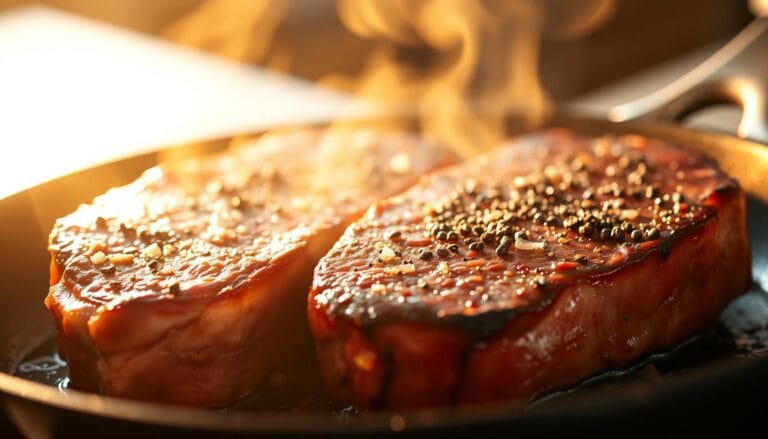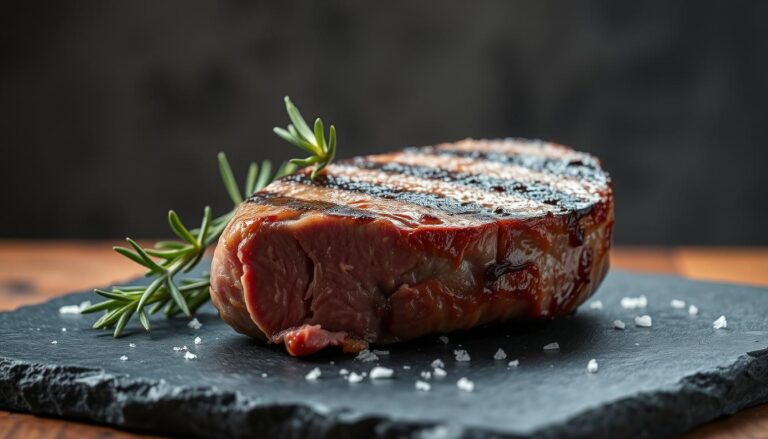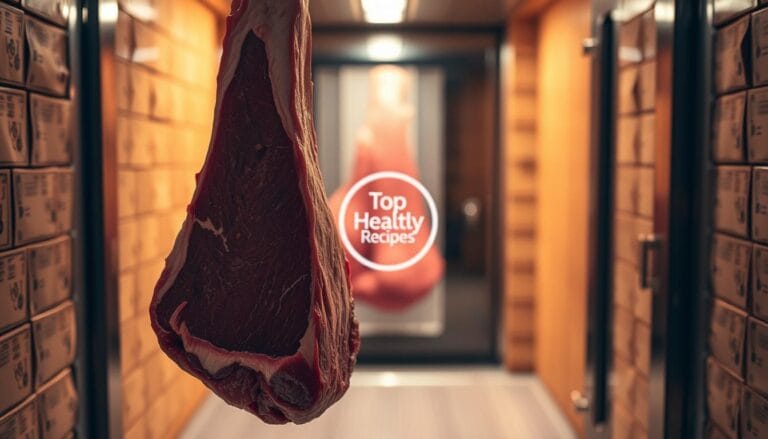What is a Denver Steak? Your Guide to This Unique Cut
Table of Contents
What is a Denver Steak? Your Guide to This Unique Cut
If you love steaks, you’ve probably tried many different cuts. The Denver steak is becoming more popular. It’s known for being tender and having a rich flavor.
So, what’s special about this steak? The Denver steak comes from the chuck section of the beef. This part is famous for its marbling, which makes it tender and full of flavor. It’s a newer cut, introduced by the National Cattlemen’s Beef Association as a top choice for steaks.
Learning about the Denver steak can make your steak experiences even better. It’s a tasty option compared to more common cuts.
Key Takeaways
- Denver steak is a relatively new cut, promoted by the National Cattlemen’s Beef Association.
- It is derived from the chuck section, known for its marbling and tenderness.
- This steak offers a rich flavor profile, making it a desirable option for steak enthusiasts.
- Understanding Denver steak can enhance your culinary experiences.
- It’s a great alternative to more traditional steak cuts.
What Makes Denver Steak Unique?
The Denver steak, also known as the ‘denver cut steak,’ is a hit in the culinary world. It’s known for its top-notch quality, rich flavor, and tender texture. This makes it a favorite among steak lovers.
Origin of the Denver Steak
The Beef Checkoff Program found the Denver steak. They looked for new, high-quality beef cuts. The Denver steak comes from the chuck section, a part not usually known for tenderness.
Characteristics of the Cut
The Denver steak is famous for its exceptional marbling. This marbling adds to its rich flavor and tender texture. It also has a unique grain pattern that makes it even more tender.
Here’s a summary of the key characteristics of Denver steak:
| Characteristics | Description |
|---|---|
| Marbling | Exceptional intramuscular fat for enhanced flavor and juiciness |
| Origin | Serratus ventralis muscle from the chuck section |
| Grain Pattern | Unique pattern contributing to tenderness |
| Flavor Profile | Rich beef flavor |
Comparison to Other Steaks
When comparing Denver steak to other cuts, tenderness, flavor, and price are key. It’s between ribeye and flank steak in tenderness and price.
Ribeye is known for its marbling and tenderness. But Denver steak offers a similar experience at a lower price. Flank steak is flavorful but not as tender as Denver steak.
In summary, Denver steak’s mix of tenderness, flavor, and price makes it a great choice for steak lovers.
The History of Denver Steak
The Denver steak has a unique history. It was ‘discovered’ in the early 2000s. Meat scientists at the University of Nebraska worked with the Beef Checkoff Program. They studied the beef chuck primal.
Development of the Cut
This study found a special muscle in the chuck primal. It became known as the Denver steak. Butchers learned to cut out this muscle.
Before, it was ground into hamburger or stew meat because it was tough. Its discovery started the Denver steak’s journey in cooking.
Popularity in Culinary Circles
Chefs started using the Denver steak for its taste and value. It showed up on fancy restaurant menus. Food writers and cooking show fans also loved it.
Social media helped introduce it to home cooks. This made it even more popular.
A famous chef said, “The Denver steak is a game-changer.” It’s great for restaurants and home cooks. It’s tender and flavorful, but not expensive.
“The Denver steak represents a perfect blend of quality, taste, and value, making it a standout in the world of steaks.”
How is Denver Steak Cut?
Learning how Denver steak is cut is key to understanding its quality. It starts with carefully taking out the serratus ventralis muscle from the chuck primal. This step needs a lot of skill and precision.
Butchering Techniques
The first step in cutting a Denver steak is finding the serratus ventralis muscle. It’s hidden under the blade bone in the chuck primal. Butchers must then carefully separate this muscle from the rest to keep it intact.
The steps to butcher a Denver steak include:
- Identifying the serratus ventralis muscle in the chuck primal.
- Separating the muscle from the surrounding tissues with care.
- Slicing the muscle against the grain to make it tender.
This detailed process is what makes Denver steak tender and flavorful. The skill needed for this is why it’s not always easy to find in regular stores.
Ideal Thickness
The best thickness for a Denver steak is between 1 to 1.5 inches. This thickness is important because it affects how it’s cooked.
A thicker cut helps control the temperature better during cooking. This leads to a better contrast between the outside and inside. Here are some key points about the thickness of Denver steak:
- The ideal thickness is between 1 to 1.5 inches.
- Thicker cuts make it easier to control the cooking temperature.
- The right thickness makes the steak taste better by creating a perfect outside-to-inside contrast.
Understanding the importance of thickness helps you appreciate the skill in cutting a Denver steak. It also makes you enjoy it more.
Cooking Methods for Denver Steak
Cooking a Denver steak right is all about the techniques. This cut is tender and flavorful. You can cook it in different ways for a great meal.
Grilling Techniques
Grilling Denver steak adds a smoky taste and a nice char. First, heat your grill to 450°F to 500°F. Season the steak and oil it up. Grill for 4-5 minutes on each side for medium-rare.
Use a thermometer to check the steak’s temperature. It should be 130°F – 135°F for medium-rare. For medium, it’s 140°F – 145°F, and 150°F – 155°F for medium-well.
Direct and Indirect Heat Grilling: For better control, use both direct and indirect heat. Sear the steak for 2-3 minutes on each side. Then, move it to indirect heat to cook it to your liking.
Sous Vide Preparation
Sous vide cooking is precise, ensuring even cooking. Season the steak, then seal it in a bag. Cook it in a water bath at 130°F for medium-rare or 140°F for medium.
After cooking, sear the steak in a hot skillet with butter or oil for 1-2 minutes on each side.
Pan-Seared Options
Pan-searing gives a crispy crust and a tender inside. Heat a cast-iron skillet over high heat. Add oil and sear the steak for 3-4 minutes on each side.
For extra flavor, baste the steak with butter during the last minute.
| Cooking Method | Temperature | Cooking Time |
|---|---|---|
| Grilling | 450°F – 500°F | 4-5 minutes per side |
| Sous Vide | 130°F – 140°F | 1-3 hours |
| Pan-Searing | High Heat | 3-4 minutes per side |
Each method brings a unique flavor to your Denver steak. Whether you like grilling, sous vide, or pan-searing, knowing these techniques will make your steak perfect every time.
Denver Steak Recipes to Try
The Denver cut steak is tender and full of beef flavor. It’s perfect for trying out different marinades and seasonings. Let’s dive into some tasty recipes that highlight this cut’s versatility.
Classic Denver Steak Marinade
A good marinade can really bring out the steak’s flavors. A mix of soy sauce, garlic, and olive oil is a classic choice. For the best taste, marinate the steak for 2 hours or overnight. But, be careful with acidic ingredients to keep the steak tender.
Here’s a simple marinade recipe to try:
- 1/2 cup soy sauce
- 1/4 cup olive oil
- 4 cloves garlic, minced
- 1 tablespoon fresh thyme
- 1 tablespoon black pepper
Flavorful Rubs
For a dry rub, there are many flavors to choose from. A simple salt and pepper rub is a good start. For something more complex, try a mix of paprika, chili powder, and brown sugar for a smoky, sweet taste.
Here are some rub ideas:
- A Mediterranean blend with oregano, thyme, and lemon zest
- A spicy rub with chili flakes, cumin, and coriander
- A classic beef rub with black pepper, garlic powder, and onion powder
Accompaniments and Sides
Choosing the right sides can make your Denver steak even better. Try it with chimichurri sauce for a tangy taste or compound butter for extra richness. Roasted veggies like asparagus or Brussels sprouts are great sides. For starch, garlic mashed potatoes or roasted sweet potatoes are perfect.
- Grilled or sautéed mushrooms
- Roasted root vegetables
- Quinoa or couscous salads
Nutritional Profile of Denver Steak
Denver steak is packed with nutrients, making it great for a healthy diet. Knowing what’s in it helps you plan meals better.
Protein Content
Denver steak is full of high-quality protein. This is good for muscles and overall health. It has a lot of protein, which is key for the body.
The protein in Denver steak is complete. This means it has all nine essential amino acids the body can’t make itself.
Fat Composition
The fat in Denver steak is well-balanced. It has both saturated and unsaturated fats. The marbling adds flavor and fat.
Compared to other steaks, Denver steak is leaner. This makes it a tasty choice for those watching their fat intake.
Vitamins and Minerals
Denver steak is full of vitamins and minerals. It’s a top source of B vitamins, like B12. B12 is important for nerves and making red blood cells.
It also has zinc, iron, phosphorus, and selenium. These minerals help with the immune system, carrying oxygen, bone health, and fighting off free radicals.
Denver steak is a nutritious addition to any diet. It’s rich in protein, has balanced fats, and is full of vitamins and minerals. It’s a great choice for any meal.
Where to Buy Denver Steak
Finding the perfect Denver steak can be tough. But knowing where to look makes it easier. Whether you’re a pro at grilling or new to steaks, getting quality Denver steaks is key for a great meal.
Start by visiting local butcher shops. They often have a wide range of high-quality meats. They can help you find Denver steaks.
Specialty Butchers
Butchers are more than just meat sellers. They’re experts who can give you tips on Denver steaks. Ask them about:
- The origin of their Denver steaks
- Aging processes to make steaks tender and flavorful
- Custom cutting options
Getting to know a butcher can improve your steak experience. They can help you find the best Denver steaks.
Grocery Store Options
If you can’t find butchers, many grocery stores sell Denver steaks. Here’s how to find them:
- Look for specialty cuts at the meat counter
- Check the pre-packaged meat section for vacuum-sealed steaks
- Ask the meat department if they have Denver steaks
Stores like Whole Foods and Wegmans often have Denver steaks. But availability can change with the season and location.
Buying Denver Steaks Online
Buying meat online is easy and convenient. Many online stores specialize in Denver steaks. When shopping online, think about:
- Pricing and discounts for buying in bulk
- Shipping to keep steaks fresh
- Quality guarantees and return policies
Online stores like Snake River Farms and ButcherBox are known for quality. They source from local farms for the best products.
When buying Denver steaks, check the quality. Look for good marbling, a deep red color, and proper packaging to keep it fresh.
Best Pairings for Denver Steak
To make the most of Denver steak’s flavor, try these wine and side dish suggestions. Denver steak’s beefy taste is perfect for many pairings. These can really bring out its natural flavor.
Wine Recommendations
Denver steak pairs well with medium to full-bodied red wines. Malbec matches its richness with plum and blackberry flavors. Syrah adds a spicy kick that boosts the flavor. For a bolder taste, Cabernet Sauvignon is great, balancing the steak’s fat with tannins.
If wine isn’t your thing, try a craft beer or fine bourbon with your Denver steak. A strong stout or porter goes well with the charred taste of grilled steak. Bourbon’s oak and vanilla can also add depth to the steak’s flavor.
“A good steak deserves a good wine, and Denver steak is no exception. The right pairing elevates the dining experience.”
Side Dishes That Complement
Choosing the right side dishes can enhance your Denver steak dinner. Classic picks like roasted potatoes and grilled asparagus offer a nice contrast to the steak’s richness. For something bolder, try blue cheese polenta or charred broccolini with chili flakes for a spicy kick.
When picking side dishes, aim for balance in flavors and textures. For example, roasted veggies can complement the steak’s savory taste. A fresh salad adds a refreshing touch.
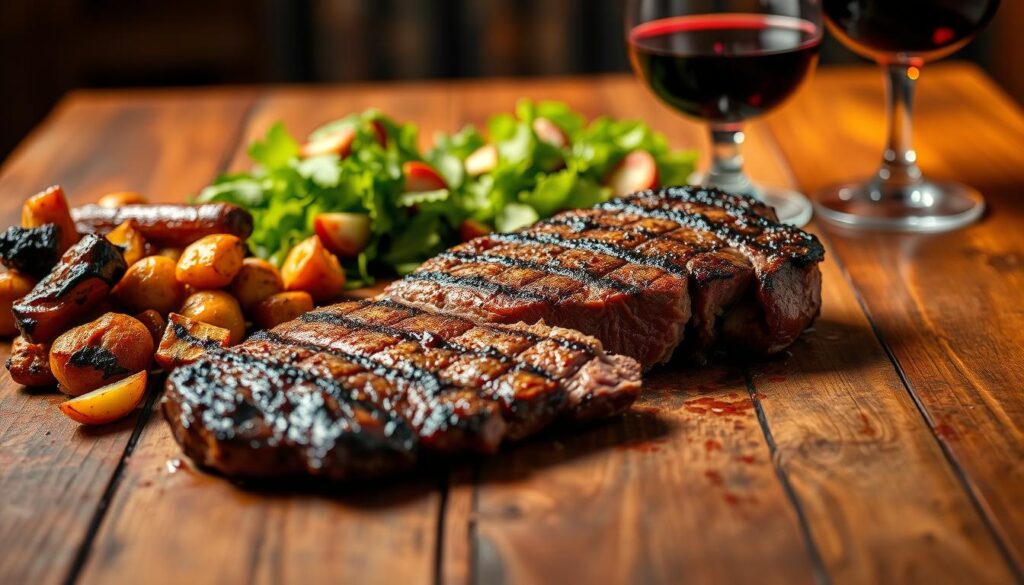
Cooking Tips for Perfect Denver Steak
A perfectly cooked Denver steak is a culinary delight. It’s all about the internal temperature and resting time. Knowing how to achieve doneness is key.
Understanding Doneness
Doneness is critical when cooking a Denver steak. The internal temperature is the best way to check if it’s done. Here are the internal temperatures for different doneness levels:
| Doneness Level | Internal Temperature |
|---|---|
| Rare | 125°F |
| Medium-Rare | 135°F |
| Medium | 145°F |
You can use a meat thermometer to check the internal temperature. Or, you can use the touch test. A rare steak feels soft, while a well-done steak feels hard.
“The touch test is a skill that develops over time with practice,” notes a seasoned chef.
“It’s not just about the temperature; it’s about feeling the steak,”
he adds.
Resting Time Importance
After cooking your Denver steak, let it rest. Resting makes the steak more tender and flavorful. A Denver steak should rest for 5-10 minutes.
Resting allows the juices to spread evenly. This makes the steak more juicy. You can cover it with foil to keep it warm, but it’s not necessary. Just let it sit undisturbed.
To sum up, a perfect Denver steak needs understanding of doneness and resting time. Mastering these will improve your steak-cooking skills and enhance your dining experience.
Common Mistakes to Avoid
Cooking a Denver steak to perfection can be tricky. Knowing what to avoid is as important as mastering the right techniques. This knowledge can make a big difference in your cooking.
Overcooking Issues
Denver steaks can become tough if overcooked. Overcooking causes a loss of moisture and changes the steak’s protein structure. This makes it less enjoyable to eat. It’s best to cook them to medium doneness.
Using a thermometer is key to getting the right doneness. For medium-rare, aim for 130°F to 135°F (54°C to 57°C). For medium, the temperature should be 140°F to 145°F (60°C to 63°C).
If your steak is overcooking, remove it from the heat right away. Letting it rest won’t fix the overcooking. But it can help the juices redistribute.
| Doneness Level | Internal Temperature (°F) | Internal Temperature (°C) |
|---|---|---|
| Rare | 120-125 | 49-52 |
| Medium Rare | 130-135 | 54-57 |
| Medium | 140-145 | 60-63 |
Seasoning Errors
Seasoning is an art that can greatly impact your Denver steak’s flavor. Under-seasoning can make it taste bland. On the other hand, over-seasoning can overpower the steak’s natural taste.
When to season is important. Season your steak about 40 minutes before cooking for better flavor penetration. Or, season it right before cooking if you’re short on time.
Creating complementary flavors is essential. A mix of salt, pepper, and herbs or spices can enhance the steak’s taste without overwhelming it.
Denver Steak in Popular Culture
The Denver steak is making waves in popular culture. It’s becoming a favorite in trendy steakhouses and on social media. People are loving its unique taste and texture.
Featured in Restaurants
Upscale restaurants across the U.S. now feature the Denver steak. Chefs love it for its tenderness and rich flavor. It’s a hit on menus everywhere.
Steakhouses are getting creative with the Denver steak. They pair it with special sauces or cooking methods. For example, some add cabernet reduction or garlic butter to boost its taste.
Social Media Influence
Social media has helped the Denver steak gain popularity. Food influencers and cooking channels are sharing recipes. They show how to grill or sous vide this cut.
Its beautiful presentation makes it a top pick for Instagram. Many share their cooking successes with the Denver steak.
Frequently Asked Questions
Many people new to Denver Steak have questions about it. We’ll cover some common ones to help you understand this unique beef cut better.
Tenderness of Denver Steak
Denver Steak’s tenderness is a big concern. It’s not as tender as filet mignon, but it’s quite tender for its cut. Its tenderness comes from its marbling and muscle structure.
Proper cutting and cooking methods can make it even more tender. This makes it a great choice for dinner.
The marbling in Denver Steak makes it juicy and flavorful. Its muscle structure, when cooked right, gives a tender bite. The tenderness can change based on the cut’s quality and cooking method.
Comparison to Ribeye
Steak lovers often compare Denver Steak to Ribeye. Let’s look at their differences:
| Characteristics | Denver Steak | Ribeye |
|---|---|---|
| Origin | Chuck Primal | Rib Primal |
| Marbling/Fat Content | Moderate | High |
| Flavor Intensity | Rich, Beefy | Rich, with a fatty undertone |
| Typical Cost | Generally more affordable | Can be more expensive |
| Best Cooking Methods | Grilling, Pan-searing | Grilling, Pan-searing, Oven Roasting |
The table shows Denver Steak’s unique qualities. It’s known for its flavor and tenderness at a lower price. Ribeye, with its rich flavor and tender texture, is a favorite for its high fat content.
Choosing between Denver Steak and Ribeye depends on your taste, cooking style, and budget. Both offer a great steak experience. Knowing their differences helps you decide for your next steak dinner.
Denver Steak and Sustainability
Denver steak is becoming more popular, which raises questions about sustainable beef. Adding Denver steak to your meals might make you think about its environmental and ethical impact.
The beef industry faces criticism for its environmental effects. Yet, Denver steak has some benefits. It supports whole-animal butchery, which reduces waste by using more of the animal.
Grass-Fed Options
Grass-fed Denver steak is good for your health and the planet. It has more omega-3 fatty acids and CLA, which might be healthy.
| Nutritional Aspect | Grass-Fed Denver Steak | Grain-Finished Denver Steak |
|---|---|---|
| Omega-3 Fatty Acids | Higher | Lower |
| CLA Content | Higher | Lower |
| Marbling | Less | More |
Grass-fed beef might have a lower carbon footprint. But, it’s important to look at grazing practices and land use.
Ethical Sourcing Practices
When choosing Denver steak, consider ethical sourcing. Look for certifications like “Certified Angus Beef” or “humanely raised” labels. These ensure the cattle were raised well.
Key Certifications to Look For:
- USDA Organic
- American Grassfed Association (AGA)
- Certified Humane
- Animal Welfare Approved (AWA)
Choosing Denver steak from ethical producers supports better farming. It promotes more humane and transparent practices.
As Denver steak’s popularity grows, so does the chance for better practices in the beef industry. Making smart choices lets you enjoy Denver steak while supporting your values.
Glazing and Saucing Denver Steak
Glazing and saucing are key steps to enhance your Denver steak. The right glaze or sauce can bring out the steak’s natural flavors. This adds a new layer to your meal. You can choose from simple enhancements or bold flavors.
Best Sauces to Enhance Flavor
Several sauces pair well with Denver steak. A red wine reduction is a classic choice. It’s rich and velvety, matching the steak’s tenderness. Mushroom sauce is also great, with earthy flavors that match the steak’s beefiness.
- Chimichurri: A bright, herby sauce that cuts through the richness of the steak.
- Compound butters: Flavored butters, such as garlic-parsley or chili-herb, add a luxurious touch.
These sauces not only taste good but also look great. Try different combinations to find your favorite.
| Sauce Type | Flavor Profile | Preparation Time |
|---|---|---|
| Red Wine Reduction | Rich, Fruity | 20 minutes |
| Mushroom Sauce | Earthy, Umami | 30 minutes |
| Chimichurri | Fresh, Herby | 10 minutes |
Glaze Techniques
Glazing your Denver steak adds a caramelized crust. This is both flavorful and looks good. A balsamic-honey glaze is sweet and tangy. A bourbon-brown sugar glaze is deep and caramelized.
“The key to a great glaze is balance – you want to enhance the steak’s flavor without overpowering it.”
Some popular glaze recipes include:
- Soy-Ginger Glaze: A savory and aromatic option that pairs well with the steak’s robust flavor.
- Balsamic-Honey Glaze: Sweet and tangy, perfect for those who like a bit of contrast.
- Bourbon-Brown Sugar Glaze: Rich and indulgent, ideal for a special occasion.
Mastering glazing and saucing can take your Denver steak to new heights.
Storage Tips for Denver Steak
To enjoy your Denver steaks at their best, it’s essential to store them correctly. Proper storage helps maintain the steak’s tenderness, flavor, and overall quality.
When it comes to storing Denver steaks, you have two primary options: freezing and refrigeration. Each method has its own set of best practices to ensure your steaks remain fresh and safe to eat.
Freezing Best Practices
Freezing is an excellent way to store Denver steaks for longer periods. To freeze your steaks effectively:
- Wrap the steaks tightly in plastic wrap or aluminum foil to prevent freezer burn.
- Consider vacuum-sealing for optimal protection against moisture and other flavors.
- Label the steaks with the date and contents.
- Store them in the coldest part of your freezer, ideally at 0°F (-18°C) or below.
When you’re ready to cook your frozen Denver steaks, thaw them slowly in the refrigerator. This method helps preserve the steak’s texture and prevents bacterial growth.
| Storage Method | Maximum Storage Time | Thawing Method |
|---|---|---|
| Freezer | 6-12 months | Refrigerator thawing |
| Refrigerator | 3-5 days | Direct cooking or refrigerator thawing |
Refrigeration Guidelines
For short-term storage, refrigeration is the way to go. To keep your Denver steaks fresh in the refrigerator:
- Store them in a covered container or wrap them tightly in plastic wrap or aluminum foil.
- Keep the steaks on the bottom shelf to prevent cross-contamination.
- Maintain a consistent refrigerator temperature between 32°F (0°C) and 34°F (1°C).
If you have cooked Denver steak leftovers, let them cool to room temperature within two hours before refrigerating. Store them in shallow, airtight containers to facilitate quick cooling and reheating.
By following these storage tips, you can enjoy your Denver steaks at their best, whether you’ve purchased them fresh or cooked them in advance.
Denver Steak and the Art of Grilling
Grilling Denver steaks needs a special touch. It’s about knowing how to use the cut’s unique qualities. Denver steaks are perfect for grilling because of their rich flavor and tender texture. When done right, grilling makes the steak unforgettable.
Perfecting Your Grill Technique
To grill Denver steaks right, start with the right grill setup. You need direct and indirect heat zones on your grill. This lets you sear the steak hot and then cook it to the right doneness in a cooler spot.
For gas grills, heat up to high heat (around 450°F to 500°F) for searing. Charcoal grills need to be heated until the coals are lightly ashed, showing they’re ready.
| Grill Type | Preheating Temperature | Searing Time |
|---|---|---|
| Gas Grill | 450°F – 500°F | 3-4 minutes per side |
| Charcoal Grill | Medium-High Heat | 4-5 minutes per side |
After heating up, clean and oil the grates. This stops sticking and helps with even browning. Place the Denver steak on the grill and sear for 3-4 minutes on each side, until it gets a nice crust.
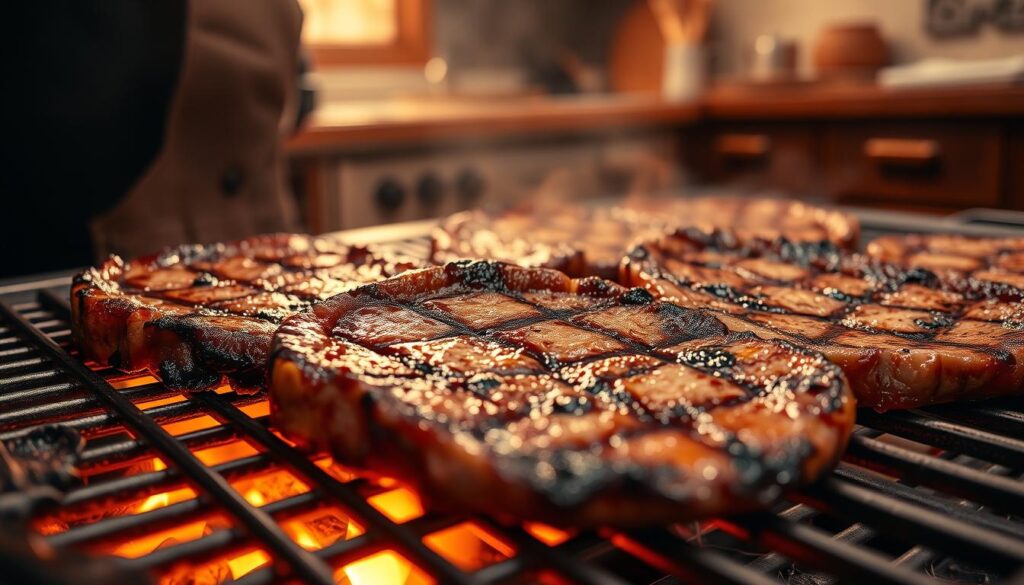
Common Grilling Mistakes
Even skilled grillers can make common mistakes with Denver steaks. One big error is not considering the steak’s thickness and fat, leading to uneven cooking.
- Not preheating the grill properly
- Overcrowding the grill
- Not letting the steak rest after cooking
To avoid these mistakes, make sure your grill is preheated right. Cook steaks one at a time if needed. Always let the steak rest for a few minutes before slicing. This lets the juices spread out, making the steak tender and flavorful.
Exploring Denver Steak Variations
You’ve learned about the Denver steak’s unique traits, cooking methods, and health benefits. Now, let’s dive into the different ways you can enjoy it. The Denver cut steak comes in various forms, from seasoned to non-seasoned, and can be cooked in many ways.
Pros and Cons of Seasoned Cuts
When picking between seasoned and non-seasoned Denver steaks, think about what you like best. Seasoned steaks are easy to prepare and taste great. But, non-seasoned cuts let you add your own flavors. Just watch out for additives in seasoned ones.
Discovering Alternative Preparations
The Denver steak is great for trying new cooking methods like smoking, reverse searing, or making fancy stir-fries or fajitas. You can also try international flavors like Korean bulgogi or Italian tagliata. This adds more taste and class to your meal.
Learning about the Denver steak and its variations opens up a world of cooking possibilities. This steak has become a favorite for its amazing taste, tenderness, and value.
FAQ
What is a Denver steak?
Is Denver steak tender?
How does Denver steak compare to ribeye?
What is the origin of the Denver steak?
How should I cook a Denver steak?
What are the best seasonings for Denver steak?
Can I buy Denver steak online?
How do I store Denver steak?
What are some good side dishes to serve with Denver steak?
Is Denver steak a sustainable choice?
What is the ideal thickness for a Denver steak?
Can Denver steak be used in stir-fries or fajitas?
For more cooking tips, stay connected with us. We also recommend the cookbook Skinnytaste Simple: Easy, Healthy Recipes with 7 Ingredients or Fewer
For more Recipes about Steak ?
Did You try our recipe ?
There are no reviews yet. Be the first one to write one.
